|
P-40N Warhawk
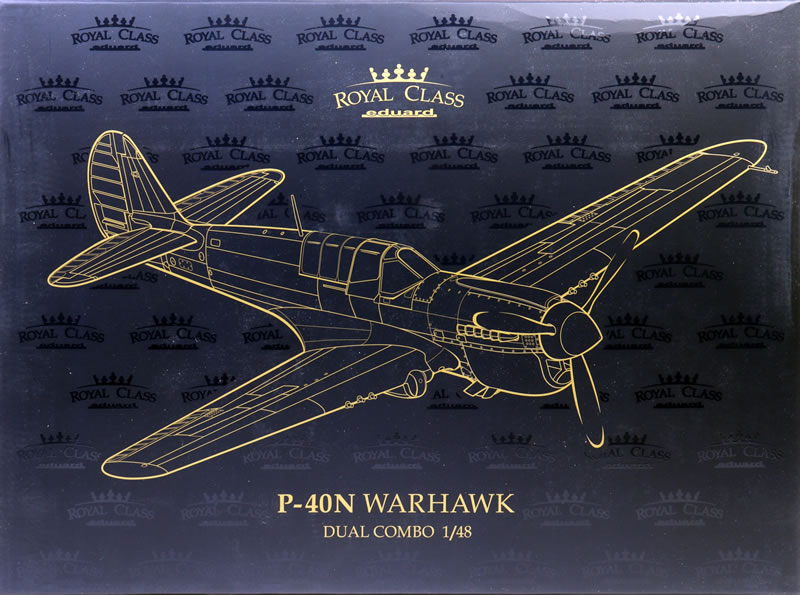
Eduard Royal Class Dual Combo
1/48 scale
S
u m m a r y |
| Description and Catalogue Number: |
Eduard Kit No. R0025 - P-40N Warhawk Royal Class Dual Combo |
| Scale: |
1/48 |
| Contents and Media: |
Total parts make up two complete models. 512 parts in grey plastic; 54 parts in clear; 35 x 3d printed resin parts; two colour photo-etched frets; die-cut self-adhesive masks; fridge magnet; A3 frameable cardbord print; decals for 12 marking options. More than 160 grey parts are marked not for use. |
| Price: |
£80.99 UK Price (£67.49 Export Price) plus shipping available online from Hannants |
| Review Type: |
FirstLook |
| Advantages: |
Parts for two models; very high level of detail; state-of-the-art surface textures; clever engineering and parts breakdown; 3d printed and conventional resin parts including seats with integrated harness straps, hollow exhaust stacks, diamond and block tread wheels six spoke and covered wheel hubs; covered and uncovered wheel well sidewalls; many useful options, large range of ordnance, aerials, avionics and more; high level of attention to detail. |
| Disadvantages: |
None noted. |
| Conclusion: |
Eduard has delivered another beautiful kit with their new 1/48 scale Royal Class Dual Combo P-40N.
Cockpit and wheel well detail match the superb standards of their best ever work.
Surface textures and the sheer number of optional parts are also class leading. This really is a Gold Standard Warhawk and a very versatile kit.
I have already built Eduard's new 1/48 scale P-40E and it was a real pleasure. I do not expect this one will be any different.
Well done Eduard and roll on with the series! |
Reviewed by Brett Green

P-40 fanciers have been kept busy over the last three decades.
Both Mauve and AMT released a series of 1/48 scale Warhawks and Kittyhawks in the mid 1990s. All these models were accurate in outline, featured finely recessed panel lines but detail was fundamental. The Mauve kit was superior in terms of surface textures; while AMT offered a better cockpit. Mauve released the P-40M and P-40N, plus their RAF equivalents (Kittyhawk III and IV); with the P-40F, K and N coming from AMT.
Revell updated their 1970s vintage 1/48 scale P-40E around the same time with a new cockpit, undercarriage and detail parts. Although it is an older model with raised panel lines, I still like the way this kit captures the rugged character of the real aircraft.
New player AMtech entered the market at the turn of the century to offer a number of previously unreleased variants based on the earlier AMT kits. These were the P-40E, plus short and long tailed versions of the P-40F and P-40L. The Merlin powered variants were enhanced with a solid resin replacement nose. This new nose was much more accurate than AMT's forward fuselage.
Eduard also got into the act, repackaging Mauve's P-40M and N kits with new markings plus resin and photo-etched detail parts.

These 1/48 scale P-40s were quite acceptable in their day and may be further improved with many after-market parts being available, but none of them are up to the standards of today's best kits.
In 2005, Hasegawa blew away the competition with their 1/48 scale P-40E, followed by a P-40K, P-40K-10, P-40M and P-40N variants as well as Commonwealth Kittyhawk Mk.I, Mk.III and Mk.IV. Hasegawa's 1/48 scale Warhawks were the best P-40 kits of their day, even taking into account the gratuitous use of inserts. Surface features were well thought out, the cockpit is one of Hasegawa's best efforts, and attention to detail is very good.

Twenty years later, in February 2025, Eduard launched their brand new 1/48 scale family of this iconic fighter. They kicked off with the P-40E and have now moved on to the P-40N.
Eduard's P-40N is the second release in their new-tool 1/48 scale P-40 Warhawk family. This has nothing at all to do with Eduard's 2002 reboxing of the Mauve kit in
Parts for two full kits are supplied in the big box.
Eduard’s all-new 1/48 scale Royal Class Dual Combo P-40N Warhawk comprises a whopping 512 parts in grey plastic; 54 parts in clear; 35 x 3d printed resin parts; two colour photo-etched frets; die-cut self-adhesive masks; fridge magnet; A3 frameable cardbord print and decals for 12 marking options.
This parts count is not really anywhere near as high as might sound. Owing to the large number of options and parts for other versions, more than 160 parts are marked not for use. You can subtract another dozen or so for alternate parts.
Your spares box will love this one!
The actual number of grey plastic parts required per model will be a little over 100 - very manageable.
Compared to the earlier P-40E release, there are four shared sprues - C, D, E and F - with the unique elements of the P-40N including the fuselage, interior parts and the clear sprue provided on three brand new sprues - G, J and K.
The parts breakdown is quite conventional. Unlike the Hasegawa kit, there are no inserts in the fuselage or the wings.

Surface detail is beautifully done with crisply recessed panel lines and selected rows of rivets. There are also a number of rows of subtly raised rivets where appropriate. The undercarriage retraction bays are a beautiful example of this symphony of surface textures.
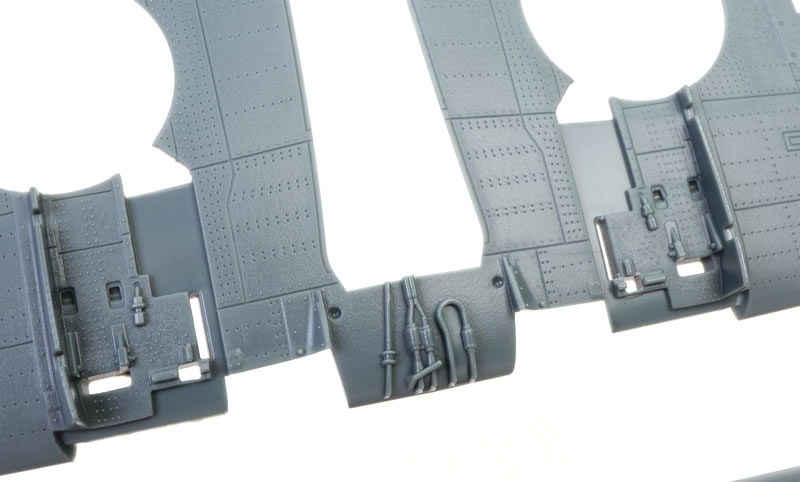
The fabric control surfaces feature restrained and convincing raised tape texture.
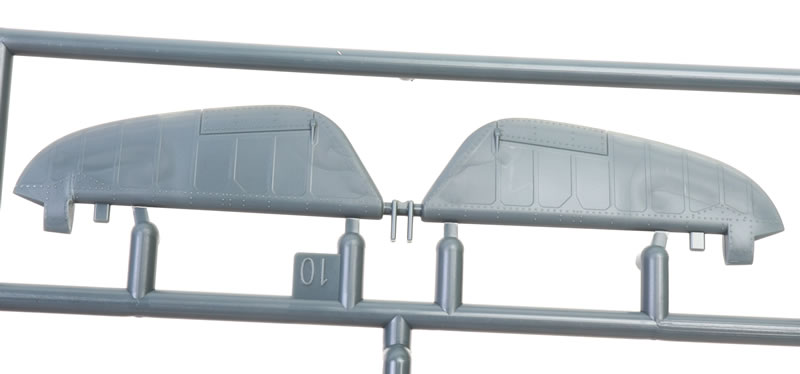
Royal Class releases usually offer a number of bonus and upgrade parts and this kit does not disappoint.

First up are the 3d resin parts.

Two pilot's seats are the highlight here. Both are the late-production square top type.
The harness straps have been printed in place and they look fantastic.
Next up are two sets of individual and hollow fishtail exhaust stacks. These feature raised weld beads.

These are mounted in a resin capsule that will in turn fit into the side engine cowling.

Rounding out the resin are eight conventionally cast wheels.
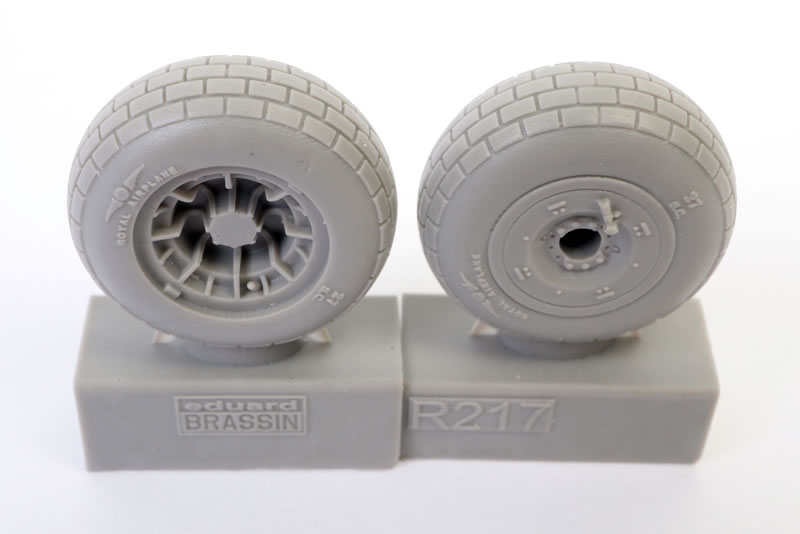
There is a pair of diamond tread and another pair of block tread wheels. The block tread tyres have raised lettering and a logo for Royal Airplane, while the diamond tread wheels are GoodYear.
Each of the wheels are cast with a hydraulic connector and air valve.
Two pairs of tail wheels are included too. Two are slick Firestones and the other pair is GoodYear with radial tread. Air valves are also moulded into these.

Next up in our box of goodies is a set of foam main undercarriage masks from O Mask. These simply press into the wheel wells after the wheel wells have been painted and before camouflage is applied. This is a handy little time saver.
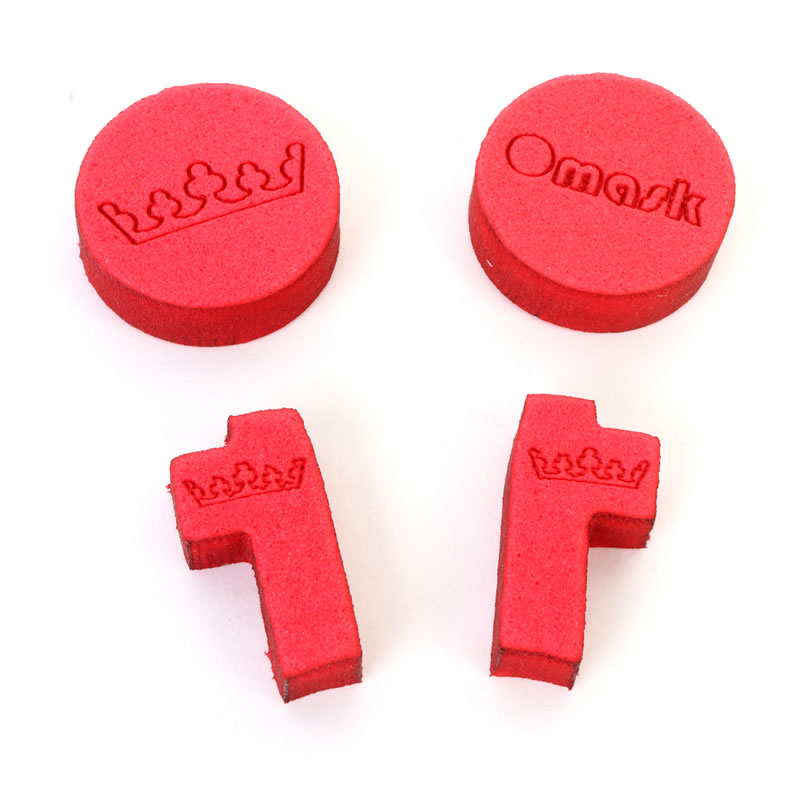
A small fridge magnet is also included.

Last of the bonus items is a A3 frameable cardbord print.

Construction gets underway in the wonderfully detailed cockpit. First up is the resin pilot's seats - two of the late-style are supplied - or the kit-supplied plastic seats with photo-etched harness straps. The choice is yours.
Photo-etched parts are also used for the instrument panel with raised bezels, quadrants and various handles and switch panels.

Alternative plastic starboard sidewall, four styles of gun sights and coaming are offered. I love the attention to detail here in the cockpit. A good example is the choice between two different actuator positions for the cooling regulator flaps. Part D7 is used for open flaps and D13 is used for closed flaps. I really like the quadrants and handles too.
The sidewall panels are separate parts.

Optional open and closed cooling flaps are supplied in photo-etched metal or plastic. Either will look good.
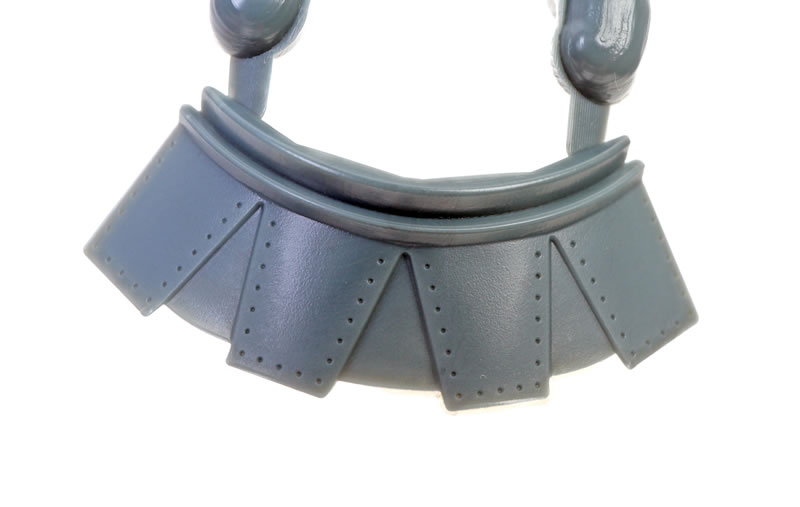
The propeller blades look good. Two sets are supplied. One appears to be the early Curtiss version.

The second has a broader chord. The instructions call out six subjects that use the narrow prop and six that use the wider prop.

The main landing gear bay is beautifully detailed and the shape is correct.
The kit provides parts for wheel wells with or without canvas covers. I am particularly impressed with the authentic textures and stitching for the covered option.

Ailerons and landing flaps are separate parts held in place with tabs. The flaps are moulded shut.
The one-piece rudder is a separate part.

The machine gun panels on the wing leading edge are recessed into the wing so no bulky separate inserts are needed.
Other options include multiple styles of metal drop tanks, 250lb US and British bombs, two triple rocket tubes, ten 5" HVAR rockets and more.
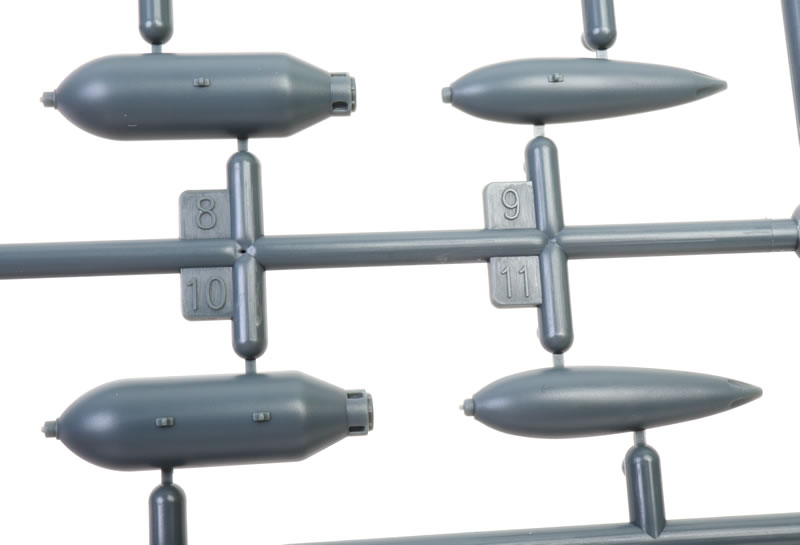
Many of these options are not required for the Warhawk markings supplied in this kit, but if you are impatient to build a later version, you'll find almost anything you could hope for right here on the sprues.
All transparencies are clear, thin and free from distortion. The windscreen is moulded with a small section of the upper fuselage, once again ensuring a clean join and painting demarcation.

The big clear arched greenhouse aft of the pilot, a traditionally tricky area, sits on the spine along natural panel lines. No more filling join seams along inconvenient inserts.

Both sprues offer options for open and closed canopies.
Gun sights, lights and lenses are also moulded as clear parts.
The instructions are called out over 28 pages. Considering this model has twelve marking options and lots of alternative parts, Eduard does an excellent job of keeping the modeller on track with regard to what parts are used for each of the schemes. The assembly diagrams help too. They are uncluttered and clearly supported by text notes.
Markings
Markings are supplied for 12 aircraft covering 7 are USAAF, two RAAF one RAF, one RNZAF and one Chinese aircraft.

A great selection of different colours and markings are offered. Here are the specific subjects:
-
82nd TRS, 71st TRG, Borokoe Airfield, Biak, summer 1944
-
1/Lt. Arthur A Bridge, 45th FS, 15th FG, Makin Atoll, Gilbert Islands, December 1943
-
8th FS, 49th FG, Biak, New Guinea, spring 1944
-
Lt. Otto Miller, 26th FS, 51st FG, Yunnanyi, China, 1944
-
Col. Ivan W. McElroy, CO of 80th FG, Tingkawk Sakan, Burma, 1944
-
Capt. Xu Hua-jiang, 7th FS, 3rd FG, Laohokow, China, January 1945
-
P-40N, Lt. Roger Farrell, 7th FS, 49th FG, Dobadura, New Guinea, spring 1944
-
Maj. Arthur W. Cruikshank, 74th FS, 23rd FG, Hengyeng, China, June 1944
-
F/Sgt. D. A. Smyth, No. 78 Squadron RAAF, Noemfoor Island, August 1944
-
No. 3 Squadron RAAF, Foiano, Jesi, October 1944
-
F/O Stanley Broadbent, No. 18 Sqn RNZAF, Torokina, Bougainville, spring 1944
-
L Sgt/Plt G. F. Davis, No 112 Sqn RAF, Cutella/Sant Angelo, Italy, March 1944

Decals are printed perfectly by Eduard.
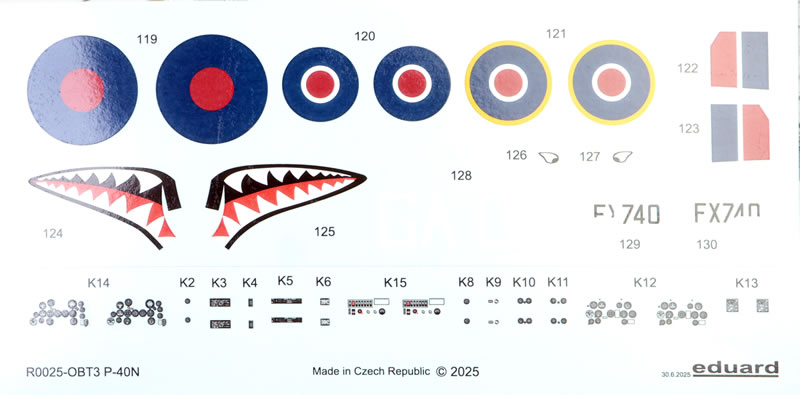
Two sets of stencil decals are supplied on separate decal sheets.
Eduard has delivered another beautiful kit with their new 1/48 scale Royal Class Dual Combo P-40N.
Cockpit and wheel wells are superb, matching the standards of their best work.
Surface textures and the sheer number of optional parts are also class leading.
I have already built Eduard's new 1/48 scale P-40E and it was a real pleasure. I do not expect this one will be any different.
This really is a Gold Standard Warhawk and a very versatile kit. Well done Eduard and roll on with the series!
Purchased by the reviewer.
Text and Images Copyright © 2025 by Brett Green
Page Created 29 July, 2025
Last updated
30 July, 2025
Back to HyperScale Main Page |
